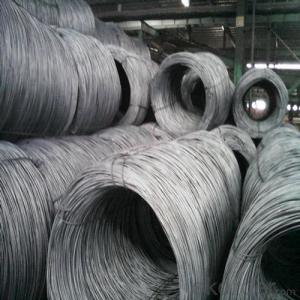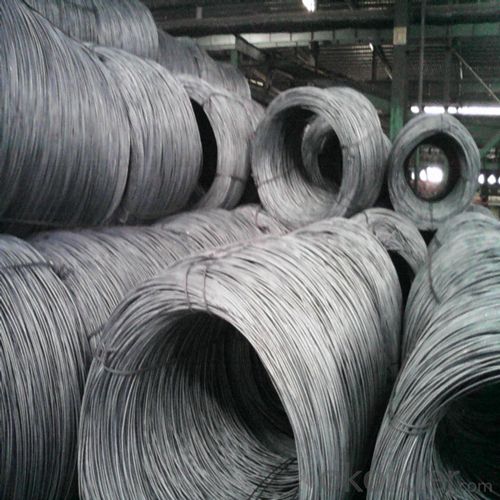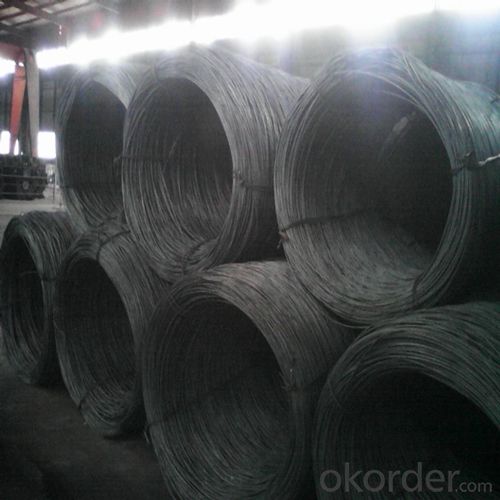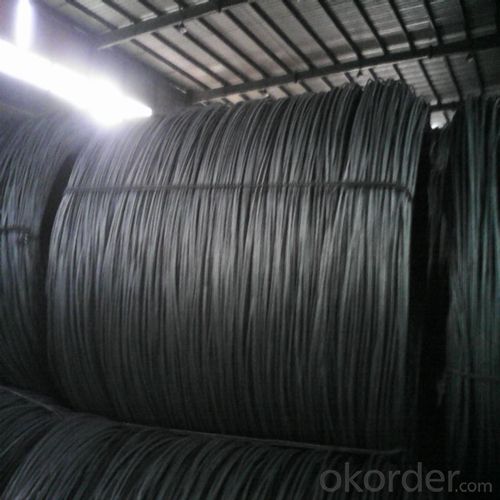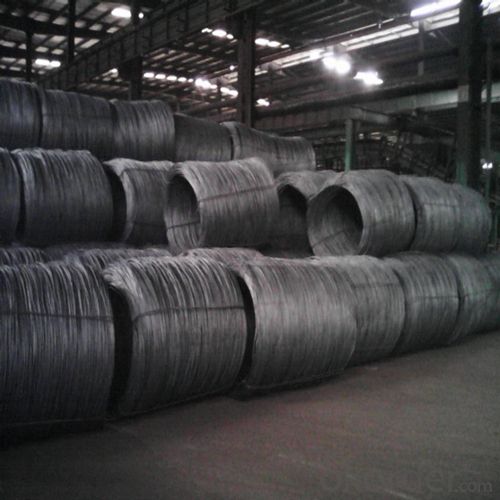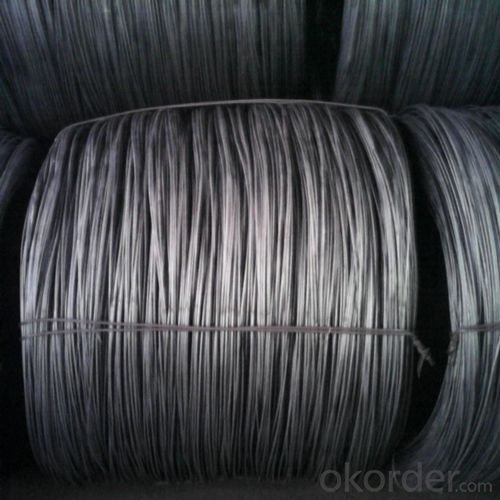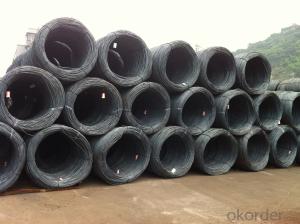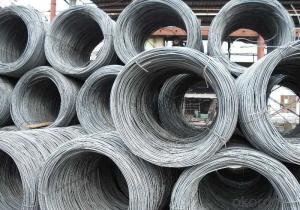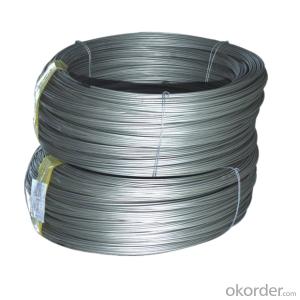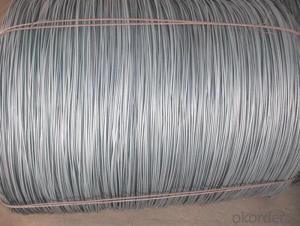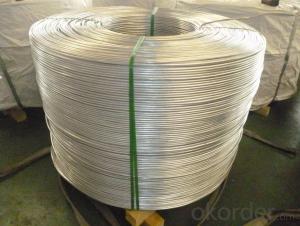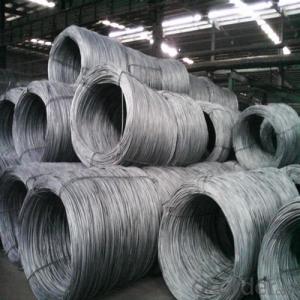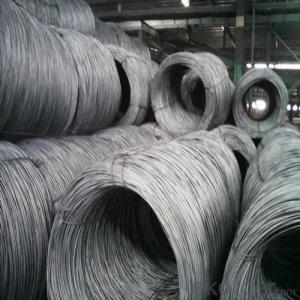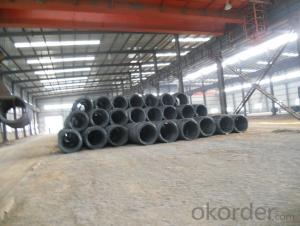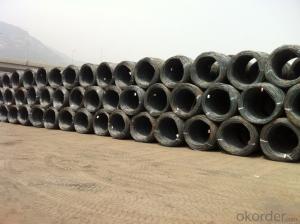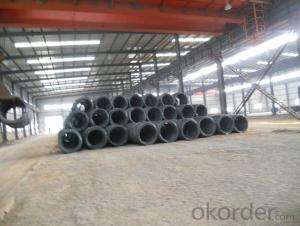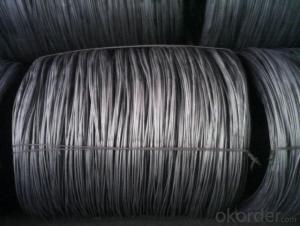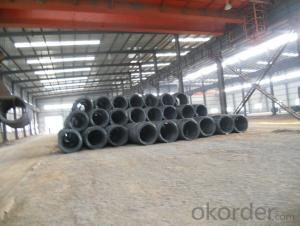Steel Wire Rod Hot Rolled SAE1008 SAE1006 SAE1018
- Loading Port:
- Tianjin
- Payment Terms:
- TT OR LC
- Min Order Qty:
- 500 m.t.
- Supply Capability:
- 30000 m.t./month
OKorder Service Pledge
OKorder Financial Service
You Might Also Like
Product Description:
Specifications of Wire Rod SAE1008B:
Steel Grade: SAE1008B Standard: ASTM, GB
Diameter: 5.5mm, 6.5mm, 7mm,8mm,9mm,10mm,12mm,14mm
Type: Drawn Wire Alloy or Not: Alloy Brand Name: N-RIVER
Technique: Hot Rolled Place of Origin: China Mainland
Chemical Composition:
Please kindly find our chemistry of our material based on SAE1008B as below for your information
Grade | Chemical Composition (%) | |||||
C | Mn | S | P | Si | B | |
SAE1008B | 0.10max | 0.32max | 0.045max | 0.040max | 0.30max | 0.0008min |
Mechanical properties | ||||||
Yield strength(N/mm2) | Tensile strength(N/mm2) | Elongation (%) | ||||
≥195 | 350-380 | ≥32 | ||||
Usage and Applications of Wire Rod SAE1008B:
After hot-rolled the products shaped into coil and delivery as finished product, including round, square, rectangular, hexagonal and so on. Since most of the products are round, it is generally called wire rod. Carbon steel wire rod is widely used in construction and manufacturing. Carbon steel wire rod is mainly used for reinforcement of reinforced concrete and welded structure or reprocessed (roberts , nail, etc.) materials, especially used to produce wire drawing, welding electrode, nails, spring, electronic, precise machinery parts and so on.
Usage and Applications of Hot Rolled Wire Rod:
After hot-rolled the products shaped into coil and delivery as finished product, including round, square, rectangular, hexagonal and so on. Since most of the products are round, it is generally called wire rod. Carbon steel wire rod is widely used in construction and manufacturing. Carbon steel wire rod is mainly used for reinforcement of reinforced concrete and welded structure or reprocessed (roberts , nail, etc.) materials, especially used to produce wire drawing, welding electrode, nails, spring, electronic, precise machinery parts and so on.
Packaging & Delivery of Hot Rolled Wire Rod:
Packaging Detail: products are packed in coil, each coil weight around 2 MT, and then shipped by container or bulk vessel
Delivery Detail: within 45 days after received deposit or LC.
Label: to be specified by customer, generally, each bundle has 1-2 labels
Trade terms: FOB, CFR, CIF
Note:
1. Our products are produced according to national standard (GB), if not, supply according to national standards (GB) or agreement as customer required.
2. Other Grade and Standard carbon steel wire rod we can supply:
Grade:H08A, 30MnSi, 62B-82B
Standard: AISI, BS, JIS, DIN
The Minimum Order Quantity of these products is high, and need to be confirmed.
3. We can not only supply carbon steel wire rod; if you need anything about building materials, please contact us.
4. Please send us your detail specifications when inquire. We will reply to you as soon as possible.We sincerely hope we can establish a long stable business relationship.
- Q: What are the common tensile strengths of steel wire rod?
- The common tensile strengths of steel wire rods vary depending on the specific grade and composition of the steel. However, some common tensile strengths for steel wire rods can range from 500 MPa (megapascals) to 2000 MPa. It is important to note that these values are approximate and can vary slightly depending on factors such as the manufacturing process and the specific application of the steel wire rod. Additionally, different industries may have different standards and requirements for tensile strength, so it is always recommended to consult the relevant standards and specifications for accurate information.
- Q: What are the different types of steel wire rod surface defects after wire drawing?
- After the wire drawing process, steel wire rods can exhibit several types of surface defects. These defects can be categorized based on their appearance and causes. 1. Scratches: Linear marks on the wire rod's surface can arise during the drawing process. They typically occur due to abrasive particles or contact with sharp edges of the drawing dies. 2. Scale: The wire rod's surface may develop a thin layer of oxide, known as scale, during the heating and rolling stages. Scale can create an uneven and rough surface, impacting both appearance and performance. 3. Pitting: Small depressions or pits can be observed on the wire rod's surface as pitting defects. They usually result from localized corrosion or uneven cooling during manufacturing. 4. Flakes: Irregularly shaped, thin pieces of metal that detach from the wire rod's surface are referred to as flakes. Excessive friction between the wire rod and the drawing dies often causes this detachment. 5. Decarburization: High temperatures during manufacturing can lead to a reduction in carbon content on the surface, resulting in decarburization. This can weaken the structure and mechanical properties of the wire rod. 6. Laps: Irregularities on the wire rod's surface can occur due to folding or overlapping of material during the drawing process, known as laps. Laps can weaken the structure and contribute to premature failure. 7. Grooves: Deep and narrow channels, known as grooves, can be seen on the wire rod's surface. They may arise from uneven wear of the drawing dies or the presence of abrasive particles during drawing. 8. Coating defects: In certain cases, wire rods may have a protective coating applied to prevent corrosion. Coating defects can include peeling, blistering, or uneven application, which compromises the wire rod's corrosion resistance. It is crucial to acknowledge that these defects can impact the quality and performance of the wire rod. Manufacturers often implement various quality control measures and inspections to identify and rectify these defects, ensuring the production of high-quality wire rods.
- Q: What are the major risks and uncertainties in the steel wire rod industry?
- The major risks and uncertainties in the steel wire rod industry include fluctuations in raw material prices, such as iron ore and scrap metal, which can impact production costs and profitability. Market demand and competition can also pose risks, as changes in consumer preferences or economic conditions can affect the demand for steel wire rods. Additionally, regulatory changes and environmental concerns surrounding the industry's carbon emissions and sustainability practices can introduce uncertainties. Technological advancements and automation may also impact the industry, requiring companies to adapt and invest in new equipment and processes to remain competitive.
- Q: What are the main markets for steel wire rod?
- The main markets for steel wire rod include construction, automotive, manufacturing, infrastructure, and energy industries.
- Q: What are the various applications of steel wire rod?
- Steel wire rods have numerous applications across various industries. They are commonly used in the construction sector for reinforcing concrete structures, such as buildings, bridges, and tunnels. Steel wire rods also find application in manufacturing wire products like nails, screws, cables, and springs. In the automotive industry, they are used to make tire cords, suspension springs, and seat frames. Moreover, steel wire rods are utilized in the production of electrical wires, fencing, mesh, and in the manufacturing of various industrial components.
- Q: What are the common steel wire rod manufacturing processes?
- Typically, the production of high-quality steel wire rods involves several steps to convert raw materials into the finished product. The specific requirements and desired properties of the wire rod may slightly alter the process, but the general steps remain consistent. To begin, high-quality raw materials, usually billets or bars, are carefully selected and tested for strength, composition, and size. Then, the selected materials undergo heating in a furnace to increase their malleability and ease of handling. Next, the heated billets or bars are passed through rolling mills to reduce their size and shape them into wire rod form. This rolling process may involve hot rolling, cold rolling, or a combination of both, depending on the desired properties and dimensions of the wire rod. After the rolling process, the wire rod is often covered with scales or oxides that need to be removed. Several methods, such as acid pickling, shot blasting, or mechanical descaling, are used to achieve a clean surface finish. Once the wire rod has been shaped and descaled, it is cooled either naturally or with the assistance of water sprays or air cooling systems. This cooling step is crucial for strengthening the wire rod and improving its mechanical properties. Depending on the intended application, the wire rod may undergo additional surface treatments such as galvanization, coating, or heat treatment to enhance its corrosion resistance, appearance, or specific properties. Throughout the manufacturing process, the wire rod undergoes various quality control checks and testing procedures to ensure it meets the required standards. These checks include dimensions, tensile strength, surface defects, and other mechanical and chemical properties. After passing all quality control tests, the wire rod is packaged and stored in a controlled environment to prevent damage or contamination. Proper packaging and storage are essential to maintain the wire rod's excellent condition until it is ready for shipment or further processing. In summary, the common steel wire rod manufacturing processes involve heating, rolling, descaling, cooling, surface treatment, and rigorous quality control measures. These processes are crucial for producing wire rods with the desired mechanical properties, dimensions, and surface finishes for various industrial applications.
- Q: Can steel wire rod be used in the production of wire mesh?
- Yes, steel wire rod can be used in the production of wire mesh. Steel wire rod is a raw material that is commonly used to manufacture various types of wire products, including wire mesh. Wire mesh is made by weaving or welding steel wires together to create a grid-like pattern. The steel wire rod is often drawn through a series of dies to reduce its diameter and increase its strength before being used to create the wire mesh. The resulting wire mesh is commonly used in a variety of applications such as fencing, construction, agriculture, and industrial settings.
- Q: What are the common applications of oil tempered and tempered steel wire rod?
- Oil tempered and tempered steel wire rods have a wide range of applications across various industries. Some common applications include manufacturing springs for automotive suspension systems, mattress springs, mechanical fasteners, wire ropes, and cables. They are also used in the construction industry for reinforcing concrete structures, as well as in the production of power transmission equipment and industrial machinery.
- Q: What are the different types of steel wire rod surface defect classification systems?
- There are multiple types of steel wire rod surface defect classification systems, including the American Iron and Steel Institute (AISI) system, the International Organization for Standardization (ISO) system, and the European standard EN 10221 system. These systems categorize surface defects in steel wire rods based on their appearance and severity, allowing for better quality control and identification of potential issues in the manufacturing process.
- Q: What are the safety requirements for steel wire rod used in ski lift wire ropes?
- The safety requirements for steel wire rod used in ski lift wire ropes are crucial to ensure the safe and reliable operation of ski lifts. These requirements are designed to minimize the risk of accidents and maintain the structural integrity of the wire ropes. Firstly, the steel wire rod used in ski lift wire ropes must meet specific material standards. It should be made from high-quality, high-strength steel that is capable of withstanding the tension and stress encountered during ski lift operations. The wire rod should adhere to international standards such as ASTM A1023/A1023M or EN 12385, which specify the minimum mechanical properties and chemical composition of the wire rod. In addition to material requirements, the wire rod must undergo rigorous testing and inspection processes. This includes non-destructive testing techniques like ultrasonic examination, magnetic particle inspection, and visual inspection to identify any defects or imperfections in the wire rod. The testing should be performed by certified and qualified personnel to ensure accuracy and reliability. Furthermore, the wire rod used in ski lift wire ropes must have a specific diameter and tolerance range to maintain the desired strength and performance. Ski lift manufacturers typically provide specifications that dictate the required diameter and tolerance for the wire rod to be used in their systems. These specifications should be followed closely to ensure compatibility and safety. It is also essential to consider the surface requirements of the wire rod. The wire rod should have a smooth and clean surface, free from any burrs, cracks, or other surface defects that could compromise the structural integrity of the ski lift wire ropes. Any surface irregularities should be addressed through appropriate surface treatments or inspections. Lastly, regular maintenance and inspection of the ski lift wire ropes are necessary to ensure ongoing safety. This includes visual inspections, lubrication, and tension checks to detect any signs of wear, corrosion, or fatigue. If any issues are identified, immediate action should be taken to repair or replace the affected wire ropes to prevent accidents or failures. Overall, the safety requirements for steel wire rod used in ski lift wire ropes encompass material standards, testing, dimensional specifications, surface quality, and ongoing maintenance. Adhering to these requirements ensures the reliability and safety of ski lifts, providing a secure and enjoyable experience for skiers.
Send your message to us
Steel Wire Rod Hot Rolled SAE1008 SAE1006 SAE1018
- Loading Port:
- Tianjin
- Payment Terms:
- TT OR LC
- Min Order Qty:
- 500 m.t.
- Supply Capability:
- 30000 m.t./month
OKorder Service Pledge
OKorder Financial Service
Similar products
Hot products
Hot Searches
Related keywords
